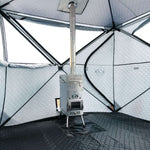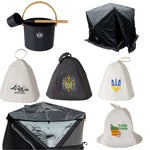Why People Build Saunas – The Appeal and the Reality
Health and Wellness Benefits
There’s something deeply primal and restorative about a sauna. The enveloping heat. The quiet stillness. The sensation of stress melting away with every bead of sweat. Whether you’re seeking detoxification, muscle recovery, mental clarity, or simply a moment to unplug, saunas have long been celebrated for their transformative wellness benefits.
Unlike a typical steam room, a traditional dry sauna relies on radiant heat and airflow rather than constant humidity. The results? Deep, gentle heat that penetrates the body and boosts circulation without creating a damp or sticky environment. Regular sauna sessions can support immune function, reduce stress hormone levels, and even promote better sleep quality.
As 2025’s wellness culture evolves, more people are trading passive wellness gadgets for time-tested, analog rituals. And few rituals rival the satisfaction of having a home sauna just steps away from your bathroom, shower room, or garden path.
The DIY Dream

The idea of building your own sauna taps into something personal. A custom retreat. A ritual space. A testament to craftsmanship and intention. For many, it’s a chance to slow down, engage in hands-on design, and create something meaningful, whether nestled in the basement, tucked inside a spare closet, or framed in a remote cabin.
And let’s be honest, there’s pride in crafting something from the ground up. Choosing the exact sauna type. Selecting high quality wood like cedar or aspen. Designing your own bench layout and control system. It’s creative. Meditative. Intentional.
But even the most passionate DIYer eventually hits a wall, literally and figuratively.
The Reality Check
But the truth? Building a sauna from scratch is not a weekend project. It demands time, tools, and a deep understanding of construction, ventilation, moisture control, and fire safety. Between navigating zoning regulations, sourcing proper materials, and ensuring safe heat distribution, many well-meaning builds fall short, either underperforming or posing real risks. That’s before you factor in the $5,000–$15,000 price tag and 40+ hours of labor.
There’s a reason so many half-built saunas sit idle in garages, back corners of the shed, or unfinished basements, waiting for the right part, the right weather, or more time.
And even when you’re ready to move forward, the logistics stack up fast: installing a stove, confirming your plumbing can handle moisture runoff, verifying electricity access, and making sure your venting plan is solid. It’s more than a woodworking project, it’s a system.
Step-by-Step: How to Build a DIY Sauna from Scratch

1. Choose Your Location for an Outdoor Sauna or Indoor Build
Before anything else, location matters. Are you building inside your house or outside in your garden, on a deck, or near a concrete foundation? Each placement has unique benefits, and challenges. Ensuring you have enough space is vital.
Indoor saunas in the basement or near a shower room offer privacy and year-round usability. But they require robust moisture control, airflow, and electrical planning. Outdoor saunas are closer to nature and easier to vent, but they’ll need weather protection, wind anchoring, and snow resistance if used in winter.
Either way, you’ll want easy access, enough ventilation, and clearance for your ceiling, chimney, or roof. Check with your city or county on local regulations before breaking ground, especially if you’re adding a wood-fired unit or connecting to household utilities.
2. Select Your Heat Source: Picking the Right Sauna Heater
Your sauna heater is the heart of the build, and your biggest decision. It defines the kind of heat experience you’ll get. Here are your main options:
-
Electric sauna heater: Popular for indoor builds, easy to wire, and efficient. However, they lack the rich, radiant heat and tactile ritual of wood fire.
-
Infrared panels: Often miscategorized as saunas. Infrared warms the body but doesn’t heat the air or generate real steam, which means no löyly (steam).
-
Wood-burning sauna heater: The most traditional and intense. Best for outdoor saunas. Heats rocks to high temps, allowing you to toss water on them for a true steam experience, closer to a steam room than a dry infrared cabin.
3. Design and Materials: What Every Home Sauna Needs
This is where the build gets technical. Framing must support high humidity. Choose high quality wood like cedar, spruce, or aspen, which naturally resists decay and doesn’t off-gas in high heat. Line the interior with tongue-and-groove planks for a clean aesthetic and solid heat retention.
Build two tiers of benches to allow users to choose their heat level. Add non-slip flooring, tiles or wooden slats, so water drains easily. Consider additional features like dimmable LED lighting, headrests, or Bluetooth sound. Even in a DIY setup, comfort matters.
And make sure you plan for adequate clearance around your heater. Too close, and your woodwork risks overheating. Too far, and the room won’t reach target temps.
4. The Importance of a Vapor Barrier in Sauna Construction
A vapor barrier is one of the most critical, yet often skipped, steps in any home sauna build. It protects your structure from moisture damage by blocking humidity from seeping into the framing or insulation.
Typically made of foil-backed materials, the barrier is installed between your insulation and your finished wall planks. Not only does this preserve structural integrity, but it reflects radiant heat back into the room, making your sauna more energy-efficient and more evenly heated.
Forget this step, and you’re basically guessing with the longevity of your entire project.
5. Installation & Assembly
Assuming you've got a solid plan, building a DIY sauna takes 40 to 80 hours of actual labor. You'll need carpentry tools, a licensed electrician if using an electric heater, and potentially a contractor if pouring a concrete foundation, running plumbing, or installing electricity.
Frame your structure with treated studs. Insulate all walls, the ceiling, and the floor. Install your vapor barrier, then line with wood paneling. Mount your benches and create vent openings for airflow regulation.
If you're placing the unit near an existing shed, garage, or outbuilding, proximity to power and water may simplify your setup, but don't overlook code compliance.
6. Testing and Safety Considerations
Before you ever fire up the sauna heater, inspect every seal, screw, and surface. Confirm that your chimney or venting system is clear, your electrical is up to code, and your space is fire-safe. You’ll also want to test the door seal, ceiling insulation, and air intake for balance.
Heat the room to full temp (usually 170°F–200°F) and watch how the system behaves. Add water to the stones and monitor how it steams, does it act more like a steam room or a true dry sauna? Adjust as needed.
Or... Skip the Build: Why Kyfe Sauna Is the Elevated Alternative

Authentic Wood-Fired Heat, No Shortcuts
Kyfe Sauna delivers the kind of heat and ritual that usually requires a cabin, a blueprint, and a local contractor. Powered by a premium wood-burning heater, Kyfe reaches temps over 200°F. Included sauna stones allow you to create rich, aromatic steam, just like a high-end steam room. Except this one sets up in under an hour.
Portable, Full-Sized Outdoor Sauna Built for Modern Life
Kyfe isn’t a pod or a gimmick. It’s a full-size dry sauna that fits 4–6 people comfortably. Whether you’re stretching solo, sweating with friends, or lying flat to decompress, there’s enough room to do it all. And when the day is done? It folds down and packs into a car.
Unlike fixed installations, Kyfe doesn’t require a concrete foundation or invasive installs. Just open the tent, secure the floor, connect the chimney, and you’re ready to go. Whether you’re in the garden, the mountains, or the back patio, this is traditional sauna culture, made mobile.
Designed for Safety and Ease — No Compromises
Every detail of the Kyfe setup is engineered with safety, ease, and performance in mind. From the heat-resistant chimney cap to the fireproof gloves, everything is thought through so you don’t have to second-guess the process. With detailed video instructions and a complete tool kit, setup is simple, even in the winter.
Time Is Luxury: Build Memories, Not a Blueprint
You could spend weekends sawing logs, sealing seams, and trying to align ceiling planks, or you could be sweating it out under a canopy of steam before dinner. Kyfe Sauna lets you skip the construction stress and step directly into the experience. It’s not just easier. It’s smarter. Because luxury isn’t just about what you own, it’s about what you no longer need to worry about.
Real Talk: Should You Build or Buy Your Sauna?

A Side-by-Side Comparison Table
|
Feature |
DIY Sauna Build |
Kyfe Sauna |
|---|---|---|
|
Heat Source |
Electric, Wood, Infrared |
Wood-burning |
|
Build Time |
40–80 hours |
< 1 hour |
|
Mobility |
Fixed |
Fully portable |
|
Cost Range |
$3,500–$15,000+ |
|
|
Cultural Authenticity |
Varies |
High — Finnish-style |
|
Risk Factor |
High (fire, mold, structural) |
Low — guided safety system |
|
Experience |
Customizable, complex |
Ready-to-enjoy, traditional |
Frequently Asked Building vs. Buying a Sauna Questions
How Much Does It Cost To Build A Sauna In 2025?
Most builds range between $3,500 and $15,000 depending on materials, size, and heat source. That doesn’t include your time investment or unexpected setbacks.
Is It Cheaper To Buy A Sauna Kit Or Build One Yourself?
Basic kits can be more affordable, but they often compromise on heat, materials, or comfort. When factoring in tools, delivery, and installation time, Kyfe often proves to be the more streamlined, cost-efficient luxury.
Can I Build A Wood-Burning Sauna In My Backyard Legally?
Regulations vary by city. Some municipalities require permits or restrict wood-burning units. Kyfe’s portable design circumvents many of these concerns by being non-permanent and for outdoor use only.
What’s The Safest Way To Get The Traditional Sauna Experience Without Building One?
A wood-fired sauna with proper airflow, pre-heated rocks, and safety controls is ideal. Kyfe Sauna was designed to deliver exactly that, without the build complexity.
How Hot Should A Real Sauna Get?
Traditional saunas run between 170°F and 210°F. Infrared saunas typically max out at 150°F. Kyfe Sauna hits well over 200°F, creating a true löyly steam experience.
Final Takeaway – Building Isn’t Always Better
Creating a sauna from the ground up can be fulfilling, but also time-consuming, costly, and complicated. For those who crave the authentic heat, the steam, and the ritual, but without the months of effort, Kyfe Sauna is the ultimate answer. It's the smarter choice for those who value tradition, performance, and the luxury of time.
Ready to Skip the Build and Start Sweating?
Explore the Kyfe Sauna Collection and discover what happens when Finnish tradition meets modern freedom. With detailed setup guides, premium components, and full-sized comfort, you’ll be soaking in wood-fired bliss outdoors before most people even finish framing their sauna door.
















